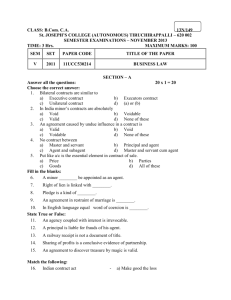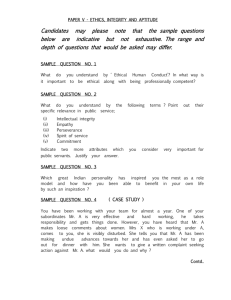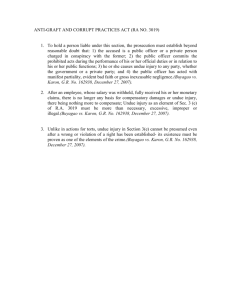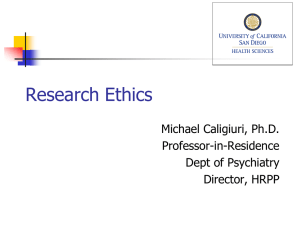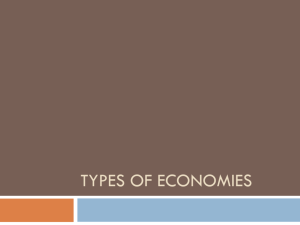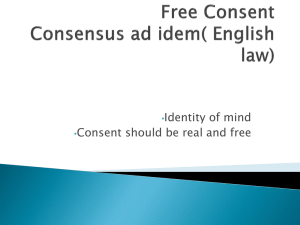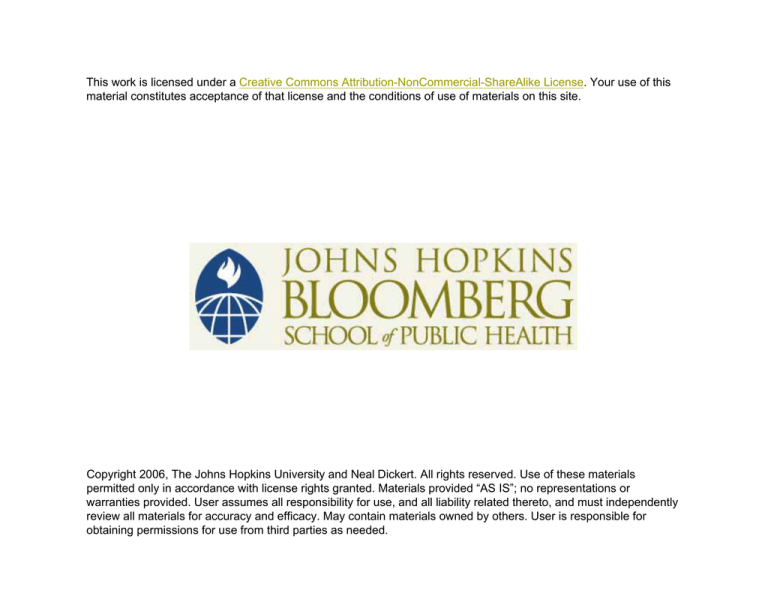
This work is licensed under a Creative Commons Attribution-NonCommercial-ShareAlike License. Your use of this
material constitutes acceptance of that license and the conditions of use of materials on this site.
Copyright 2006, The Johns Hopkins University and Neal Dickert. All rights reserved. Use of these materials
permitted only in accordance with license rights granted. Materials provided “AS IS”; no representations or
warranties provided. User assumes all responsibility for use, and all liability related thereto, and must independently
review all materials for accuracy and efficacy. May contain materials owned by others. User is responsible for
obtaining permissions for use from third parties as needed.
Coercion and
Undue Inducement in
Research:
Money and Other Offers
Neal Dickert
Johns Hopkins School of Medicine and
Bloomberg School of Public Health
Question of the Day
• Asking your student to give a lecture in
class is :
•
•
•
•
•
•
A) Coercive
B) Unduly influential
C) Exploitative
D) None of the Above
E) A Nice Gesture
F) Torture for the audience
Alexis St. Martin
• “The Intrepid Guinea Pig of the Great Lakes”
• In 1822, accidentally shot in the gut and left
with a permanent gastric fistula.
• William Beaumont paid him room, board,
and $150 a year for use of his stomach.
http://www.guineapigzero.com/AlexisStMartin.html
Walter Reed
•
•
•
•
•
Yellow fever studies in Cuba (1900).
Intentional exposure.
Paid $100 in gold.
$100 bonus for successful infection.
Payable to family in the event of death.
http://etext.lib.virginia.edu/healthsci/reed/commission.html#vol
Payment Today
• “Make $1,000's... Get paid hundreds weekly in
additional cash income, part-time, while relaxing
in a million-dollar, get paid research study…
Yes, there are thousands of cash paying studies
and even free medical care available!”
• “Get paid up to $1,000 weekly for safe sex
research?”
http://www.rxgetpaid.com
Payment Today
“There are lots of good reasons to rent your
body to science: the advancement of
knowledge, the opportunity to help future
generations - oh, who are we kidding? The
bottom line is that by "volunteering" to
participate in medical experiments (a.k.a.
being a "human guinea pig"), you can pick
up some well-earned cash.”
http://www.soyouwanna.com/site/syws/guineapig/guinea
pig.html
Other forms of payment
Research studies and opportunities for free treatment
•
•
•
There are lots of ways to fight eating disorders. One way is to
participate in research. Well-done studies help us understand why
people become eating disordered, how they recover, and how
treatment can be made more effective.
In addition, it's sad but true that treatment for an eating disorder is
prohibitively expensive for many people, and insurance coverage
tends to be minimal at best. Many research projects offer free
treatment to qualified participants. Some even pay stipends, and
procedures are supervised by clinical staff with professional
credentials.
The treatment you receive in a study probably will not last for the
several months, or even years, required to support full recovery, but
it certainly can help you define the path you need to follow. And
give you hope that recovery is possible.
http://www.anred.com/res.html
Research in Developing Countries
• Access to ARVs in preventive HIV vaccine
trials.
• Clearly desired by any subject participating
• Raised concerns that it is “too attractive to
refuse.”
• Burial expenses for an autopsy study of
cerebral malaria in Malawi.
Mfutso-Bengo and Taylor, Trends in Parasitology. 2002.
Payment Concerns
• Deaths of paid research subjects
• Nicole Wan
• Ellen Roche
• “Stuck for Money- To Screen New Drugs
for Safety, Lilly Pays Homeless
Alcoholics.”
Cohen L. Wall Street Journal. Nov. 14, 1996.
Tensions Today
“Because payment for participation can
have coercive or exploitative effects on
potential subjects, institutional review
boards (IRBs) generally take into
consideration the amount and
distribution of proposed monetary
payments to subjects to ensure that
subjects in the study will not be unduly
influenced to participate.”
Schonfeld, et al., IRB. 2003.
Overview
• State of payment in the US
• Coercion
• Undue Inducement
• Existing Views
• A New Definition
• Exploitation
• Data on Ethical Concerns in Practice
The Common Rule
“An investigator shall seek such consent
only under circumstances that provide
the prospective subject or the
representative sufficient opportunity to
consider whether or not to participate
and that minimize the possibility of
coercion or undue influence.”
45 CFR 46.116
FDA
“Payment to research subjects for participation
in studies is not considered a benefit, it is a
recruitment incentive... The IRB should review
both the amount of payment and the proposed
method and timing of disbursement to assure
that neither are coercive or present undue
influence.”
FDA Information Sheets, 1998
OHRP
“… the IRB should review both the amount of
payment and the proposed method of disbursement
to assure that neither entails problems of coercion or
undue influence. Such problems might occur, for
example, if the entire payment were to be contingent
upon completion of the study or if the payment were
unusually large. Payments should reflect the degree
of risk, inconvenience, or discomfort associated with
participation.“
Office of Human Research Protection. IRB Guidebook.
Payment in the U.S.
• At least 23% of protocols at academic
institutions paid subjects.
• Few have any method of tracking paid
studies
• Frequency of payment higher at
independent IRBs and pharmaceutical
companies.
• “most” and “about 80%”
Dickert, Grady, and Emanuel. Annals of Int Med. 2002
Types of Studies Paying Subjects
(n=467 studies)
Phase I
Phase II
Phase III
Phase IV
Physiologic
Behavioral
Other
Total
26
58
100
36
88
82
77
467
5.6%
2.4%
21.4%
7.7%
18%
17.6%
16.5%
-
Grady, Dickert, Jawetz, and Emanuel. In press
Amount of Money Being Paid
(n=467 studies)
< $100
30.4%
$100-249
$250-499
33.6%
21.2%
$500-999
$>1,000
10.5%
4.3%
Mean
Median
$266
$155
Amounts shown in U.S. dollars
Grady, Dickert, Jawetz, and Emanuel. under review
How are Decisions Made?
• 8/32 institutions had any specific guidance.
• Significant variation within and between
institutions in amount of payment for
particular procedures, inpatient days,
outpatient visits.
Dickert, Grady, and Emanuel. Annals of Int Med. 2002.
How is Payment Described? (n=31)
Academic Pharm/
(n=9)
Biotech
(n=6)
Incentive
4
4
Time
7
6
Travel
6
5
Inconvenience 8
6
CROs/
SMOs
(n=8)
5
6
5
6
Indep.
IRBs
(n=8)
5
8
5
6
Risk
1
6
3
0
The State of Payment in the U.S.
• Payment is very common.
• All types of subjects are paid.
• Payment is erratic with little institutional
guidance or consistency.
• Payment is generally modest.
• Significant disagreement over payment as
incentive or for risk.
Ethical Concerns
• Concerns focus on the enrollment of
vulnerable populations.
• Poor and homeless
• Sick patients
• Children
• Often cast as worries about coercion,
undue inducement, and exploitation.
Coercion
“By now it is an unquestioned ethical precept
of biomedical and behavioral research
practice that subjects should not be coerced
into participating… Those who choose to
participate in research should be capable of
choosing freely; they must do so voluntarily,
willingly, without duress, and without being
subjected to threats or the promise of too
great a reward.”
Macklin, IRB. 1981.
Coercion
“… [A] patient suffering from a lifethreatening disease may feel as though she
has little choice regarding treatment.
Physicians should be aware of how
vulnerable patients may be to the coercive
influence of unrealistic hope, especially
those suffering from chronic, life-threatening
disorders.”
Berg, Appelbaum, Lidz, and Parker, Informed Consent:
Legal Theory and Clinical Practice. 2001.
Coercion
• Used in many different circumstances,
often incorrectly.
• Often misunderstood as simply meaning
involuntary or under strong influence.
• Particularly misused to refer to situations
in which there are no good options.
• Because coercion is not a benign
accusation, the concept is in need of
clarification and should be used carefully.
The Belmont Report
“Coercion occurs when an overt threat
of harm is intentionally presented by
one person in order to obtain
compliance.”
National Commission, 1979
Coercion Requires a Threat
• Classic case- “your money or your life”
• Structure- A wants B to do X. If B does not do
X, A will make B worse off than B was before
the interaction.
Wertheimer, Coercion. 1987.
• If B refuses, B will be worse off than if A had
never approached him.
• Some may claim that B’s decision may be
voluntary in some strict sense. The problem is
that it’s made under a threat of harm.
Can Payment be Coercive?
• Payment is an offer and not a threat.
• To be coercive, a subject who refuses
must be made worse off than if he or she
would have been if never asked.
• Payment for research is not coercive.
Can Other Offers be Coercive?
• ARVs in the setting of vaccine trial.
• Very attractive but not a threat.
• Burial expenses for autopsy study.
• Very attractive but not a threat.
• In neither case is a subject worse off for
refusing than never being asked.
• That people will enroll may be predictable,
but this does not make an offer coercive.
• Cell phones for IPT study in S. African
mines?
Coercion is Rare in Research
• Cases where retribution is conceivable.
• Inmate may receive poor treatment for refusing.
• A physician may threaten to abandon a patient who
refuses to participate in a study.
• Perceived coercion is possible.
• Patient participates in a study run by his PCP
because the patient fears his care is contingent on
participation.
• Payment or other incentives may be involved in
these cases, but they have nothing to do with
coercion.
Inducement
• Inducements are offers that get people to
do things they would not otherwise do.
• Acceptable inducement
• Higher salaries or other perks for jobs.
• Giveaways by stores induce us to shop.
• Advertisements
• Inducements in research
• Any activity to encourage participation.
• Pure reimbursement- pay for parking.
• What inducements are acceptable?
Undue Inducement
“…monetary inducements may be undue if
they alter patients’ decision-making
processes such that they do not
appropriately consider the risks of
participating.”
Halpern, et al., Arch Intern Med. 2004
The Belmont Report
“Undue influence… occurs through an offer
of excessive, unwarranted, inappropriate,
or improper reward or other overture in
order to obtain compliance.”
National Commission, 1979
Undue Inducement
“An offer one could not refuse is essentially
coercive (or "undue"). Undue inducements may
be troublesome because: (1) offers that are too
attractive may blind prospective subjects to the
risks or impair their ability to exercise proper
judgment; and (2) they may prompt subjects to
lie or conceal information that, if known, would
disqualify them from enrolling -- or continuing -as participants in a research project.”
Office of Human Research Protection. IRB Guidebook.
Undue Inducement
“Payment in money or in kind to research
subjects should not be so large as to
persuade them to take undue risks or
volunteer against their better judgment.
Payments or rewards that undermine a
person’s capacity to exercise free choice
invalidate consent.”
CIOMS, 2002, Guideline 7.
Undue Inducement
• Individuals induced by large amounts of
money are acting involuntarily and may be
exposed to significant risk.
• They may be blinded to the risks of
participation and thus make uninformed
decisions.
• They may lie or conceal information.
Undue Inducement
• There is an offered good.
• The good is excessively attractive.
• It leads people to exercise poor
judgment.
• Participation involves a risk of serious
harm.
Emanuel, J Law Med Ethics. 2004.
Undue Inducement
• Payment cannot be undue inducement in an
appropriately approved study.
• Enrolling in such a study cannot represent
poor judgment.
• IRBs should not approve studies that expose
subjects to serious risk of harm.
• Limited agreement with McNeill’s argument.
Emanuel, J Law Med Ethics. 2004.
Undue Inducement
• Concern seems misdirected if a study
involves no risk.
• No worry about paying $500 to ask people
about their favorite color or to do a fingerstick
blood glucose test.
• Participating in research is generally very
safe.
• If it isn’t, the problem is with the IRB and not
with the money.
Undue Inducement
• Concerns about voluntariness are
counter-intuitive.
• Why would payment for research
compromise voluntariness when it doesn’t in
other settings?
• Doing what you want is typically thought of as
voluntary.
Undue Inducement
• Concerns about consent are misdirected
• If consent is compromised, improve
the consent process.
• It isn’t clear that changes in payment
are the right solution.
Undue Inducement
• There is an offered good.
• The good is excessively attractive.
• It leads people to exercise poor
judgment.
• Participation involves a risk of serious
harm.
Emanuel, J Law Med Ethics. 2004.
Undue Inducement
• Two concerns with this view:
• Reasonability of risks to different people
varies.
• Non-risk determinants of poor judgment that
involve violations of fundamental values or
important preferences.
Reasonability of Risk Varies
• Risk tolerance lies on a spectrum from
extreme daredevil to extreme caution.
• IRBs simply cannot, and should not,
accommodate the whole range of risk
tolerance.
• But, as studies get riskier, and as payment
goes up, it becomes more likely to induce
people to take risks that make them very
uncomfortable.
Reasonability of Risk Matters
• Risk tolerance is an important part of one’s
self-conception.
• The meaning of exceeding risk tolerance
will vary but can be significant.
Non-Risk Determinants of Judgment
• Values other than risk may make people
significantly averse to particular studies.
• Example: Some people have value-based
objections to getting undressed in front of
members of the opposite sex. A study paying a
lot of money but requiring them to disrobe may
lead them to act contrary to those values.
• They may not be wrong to override these values
or strong preferences, but it may be worrisome
to institutionalize practices that encourage them
to do so.
Undue Inducement- New Definition
Undue inducements are excessively attractive
offers that lead people to do something to which
they would normally have real objections based
on risk or other fundamental values.
• Acting contrary to important values better
captures the nature of undue inducement
concerns.
• In most cases, risk will be the primary objection
but is not the only consideration.
But why is this really wrong?
• Worrisome to institutionalize practices that
express disregard for human values and
dignity.
• Especially in the setting of institution designed
primarily to improve health.
• More to respect than just honoring the
decisions of capacitated adults.
Is Undue Inducement a Concern?
• Likely to be rare in protocols approved by
diligent IRBs.
• Can neither be completely dismissed nor
completely eliminated.
• A reason for caution at the ends of the
spectrum of risk or in settings where
subjects likely have values in conflict with
the research.
• Not just the IRB’s responsibility.
Examples
• ARVs in vaccine study.
• Depends on the nature of the study.
• If a Phase III study where risks are low and no
reason to think subjects object to participation,
little concern about undue inducement. To what
would they object?
Examples
• Burial expenses for autopsy study.
• More complicated case.
• Depends on how autopsy is viewed and the
attractiveness of burial expenses.
• May be unduly influential if participants likely
to feel they have violated their values,
undermined their dignity.
• Not undue inducement if subjects likely to
accept wouldn’t do it otherwise but basically
accept the need for the study and feel
comfortable about participating.
• Shows the importance of careful local review.
Exploitation
• Raised as a concern when enrolling
vulnerable populations.
• Enrolling Cambodian sex workers
without access to care in RCT of
tenofovir for HIV prophylaxis.
• Enrolling prisoners in a malaria study
• “An exploitative transaction is one in
which A takes unfair advantage of B.”
Wertheimer, Exploitation. 1999.
Exploitation
• Solution- Offer more?
• Exactly what participants suggested in
Cambodia.
• Hardly satisfies opponents and raises
concerns about undue inducement.
• Significant tension exists between
concerns about exploitation and undue
inducement.
Exploitation and Undue Inducement
• Issues of exploitation are central
and are far from settled.
• Figuring out how to fix unfair
advantage exploitation will require
confronting undue inducement.
• Highlights the importance of clarity
on undue inducement as a concern.
Concerns about Justice
• Pay will lead the poor to accept a
disproportionate research burden.
• Empirically unknown- On a broad level, we don’t
know who participates in research.
• What is the worry if risk is acceptable?
• What if people enrolling see participating as
a net benefit and not a net burden?
Concerns about Justice
• The only true fix is to pay people according
to existing income or not at all.
• Unequal pay also seems to violate justice.
• The real worry is one about exploitation,
about taking advantage of people.
Scientific Impact of Payment
• Do people conceal information to get into
studies?
• Are they unlikely to report adverse events,
compromising science and jeopardizing
safety?
• Does payment skew the population in
scientifically relevant ways?
• The answer- we don’t know.
What do the Data Show?
• Motivations of paid subjects
• Money is important but not the only factor.
• 50-95% of subjects motivated primarily by
money.
Bigorra and Banos, 1990; Vrhovac, Francetic, and Rotim,
1990; van Gelderen, et al., 1993; Novak, Seckman, and
Stewart,. 1977; Martin, et al., 1968; Hassar and
Weintraub, 1976; Aby, Pheley, and Steinberg, 1996.
• Very little data on the kinds of tradeoffs
subjects will make for money.
Negative aspects of research
•
•
•
•
•
•
•
•
•
•
•
None
Pain/side effects/scarring:
Poor procedures (painful blood draws):
Uncertainty of the risks and unknown:
Time commitment:
Lack of activities/bad or no perks:
Staff mean/unpleasant
Not home/with family:
Didn’t pay enough
Restrictions on diet/drugs/cigs/alcohol:
Other
Kass, et al. do not cite.
20.0%
21.7%
20.0%
20.0%
16.7%
16.7%
15.0%
5.0%
5.0%
1.7%
1.7%
What do subjects want?
• Interviewed 963 Ugandans
• Participants (paid/unpaid), decliners, residents of
uninvolved communities, and community leaders
• 72 % said subjects should be compensated
•
•
•
•
40% money
15% food
22% health care
5% health item
Grady et al., do not cite
What do subjects want?
• Of those who wanted money
• 27% < 10,000 Ush
• 42.6% - 10,000-50,000 Ush
• 30.3% > 50,000 Ush
• Hypothetical vaccine trial
• 43.9%- Travel $ and health hygeine- related item
• 22.2%- Health hygeine related item alone
• 21.6%- Travel $ and small payment in Ush
Grady et al., do not cite
Influence of Payment on WTP
• Payment influences
willingness to
participate.
• Influence of payment
may level off.
• Relative influence of
payment seems
stable as risk
increases.
Halpern, S. D. et al. Arch
Intern Med. 2004
Graph adapted by CTLT
Effect of payment on understanding
• No interaction between amount of money
and risk rating in hypothetical scenarios.
Bentley and Thacker, J Med Ethics. 2004.
• No data on understanding in actual
subjects who are paid versus unpaid.
Summary
• Coercion requires the presence of a threat
of harm if a subject refuses participation.
• Undue inducements are very attractive offers
that lead people to do something to which
they would normally have real objections
based on risk or other fundamental values.
• Exploitation and undue inducement exist in
tension.
Recommendations
• More empirical work
• Tradeoffs people will make for different kinds of
offers.
• Concerns people have about participating in
research.
• Impact of offers on safety and data integrity.
• Focus on the study first, then the offer.
• Undue inducement is important to consider at
the limits of approvability and when
fundamental values are known to be stake.
Wage Payment Model
• Treats research as a form of unskillled labor
• Mere reimbursement
• Market-based payment/incentive
• Standardized payment for time and for
procedures.
• Payment based on the unskilled labor
market.
• Particularly opposed to McNeill’s objection to
considering research participation to be
work.
Wage Payment Model-Advantages
• Provides consistency.
• Treats research participation as labor.
• Offers appropriately limited protection from
undue inducement.
• Prevents unfair advantage exploitation by
ensuring reasonable standard payment tied to
the nature of the work
• Controls research costs.
Questions
• Is it right to consider research participation
a job like other forms of work?
• Should payment be considered an
incentive?
• Should we allow payment for risk?
• What is the right fix for the tension between
undue inducement and exploitation?
• Was I coerced, unduly influenced,
exploited, or none of the above?
Cases
• IPT Case Study from last week
• Is the provision of cell phones problematic from
an ethical perspective?
• Autopsy Study in Malawi
• Does payment of burial expenses constitute
undue inducement?
• ARVs in vaccine studies
• Is undue inducement a concern?


